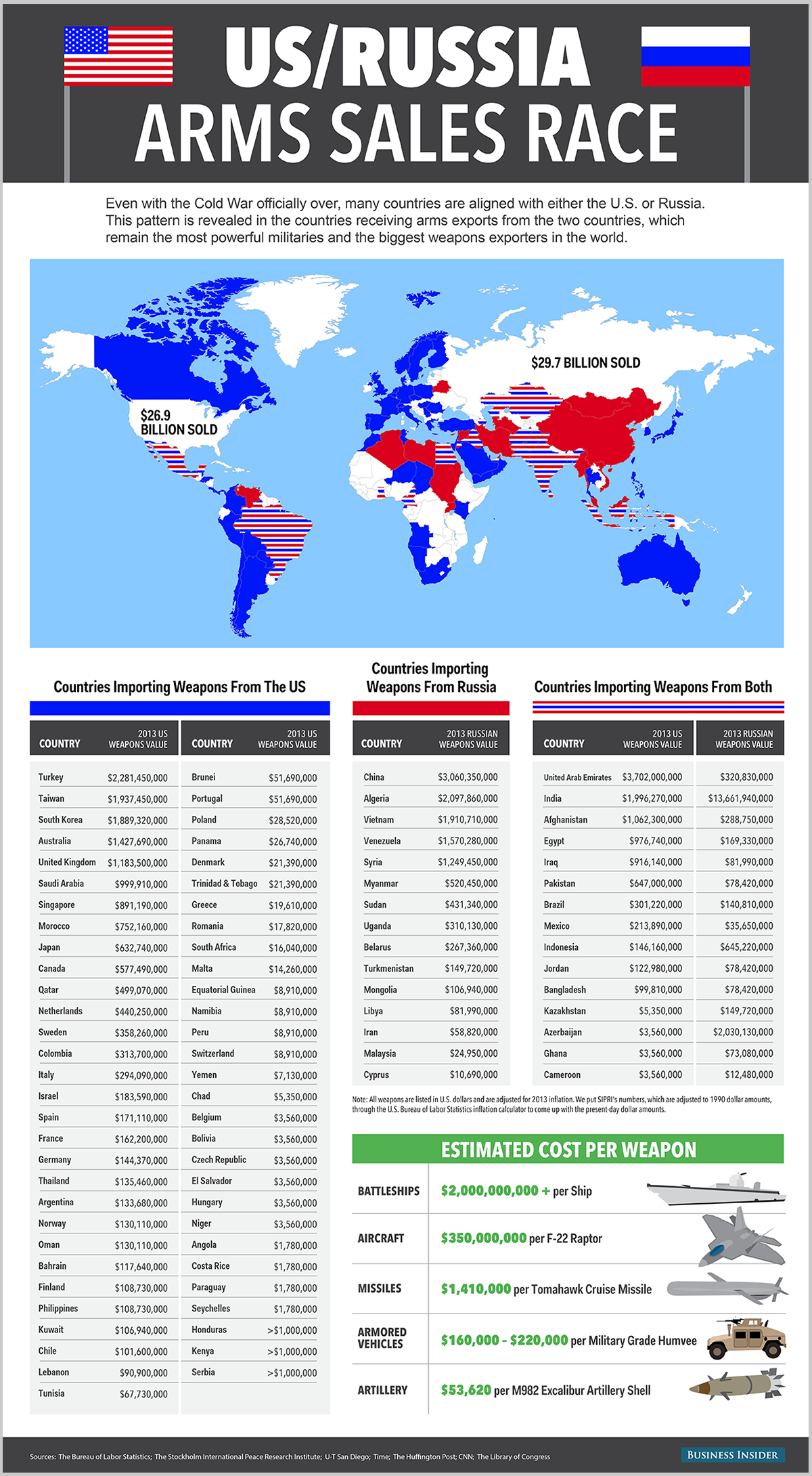This Map of US and Russian Arms Sales Says It All
MILITARISM, 18 Aug 2014
Allan Smith and Skye Gould – Business Insider
13 Aug 2014 – They say the Cold War is over, but Russia and the U.S. remain the leading suppliers of weapons to countries around the world and are the two biggest military powers. Lately, tensions have been pretty high, too.
The U.S. supplies much of NATO and Middle Eastern allies like Turkey, Israel, and Saudi Arabia.
Russia supplies many BRIC nations, as well as Iran, much of Southeast Asia, and North Africa.
We took numbers from the Stockholm International Peace Research Institute for 2012-2013 to see whom the two rivals were supplying with weaponry. The U.S. dealt to 59 nations that Russia doesn’t sell or send weaponry to, while Russia dealt to just 15 nations that don’t receive U.S. arms. Fifteen countries received weaponry from both the U.S. and Russia, including Afghanistan and Iraq.
The country that received the highest dollar amount of U.S. weaponry was the United Arab Emirates, with more than $3.7 billion in arms received over that period. Russia dealt the greatest value of weapons to India, sending more than $13.6 billion.
Overall, the U.S. sent more than $26.9 billion in weaponry to foreign nations, while Russia sent weaponry exceeding $29.7 billion in value around the globe.
Interestingly, the U.S. actually recieved roughly $16 million worth of weaponry from Russia. This was part of a $1 billion helicopter deal the two nations made so that the U.S. could supply Afghan security forces with equipment they were already more familiar with.
Importantly, SIPRI’s totals don’t measure the cost of the transaction but the cost of the weapons’ production. The numbers are listed as the production value of the weapons sold rather than the amount they were actually sold for. In addition, SIPRI does not track the transfer of certain small arms.
SIPRI gives several examples to explain their chosen method. In 2009, six Eurofighters valued at $55 million each were delivered by Germany to Austria. Therefore the delivery was valued at $330 million, even though the actual transaction likely netted a much higher total. For comparison, when The New York Times listed the total of weapons sold by the U.S. at $66.3 billion in 2011, SIPRI came up with a much lower total based off of production cost of $15.4 billion.
You can read the full explanation of SIPRI’s calculations here.
Go to Original – businessinsider.com
DISCLAIMER: The statements, views and opinions expressed in pieces republished here are solely those of the authors and do not necessarily represent those of TMS. In accordance with title 17 U.S.C. section 107, this material is distributed without profit to those who have expressed a prior interest in receiving the included information for research and educational purposes. TMS has no affiliation whatsoever with the originator of this article nor is TMS endorsed or sponsored by the originator. “GO TO ORIGINAL” links are provided as a convenience to our readers and allow for verification of authenticity. However, as originating pages are often updated by their originating host sites, the versions posted may not match the versions our readers view when clicking the “GO TO ORIGINAL” links. This site contains copyrighted material the use of which has not always been specifically authorized by the copyright owner. We are making such material available in our efforts to advance understanding of environmental, political, human rights, economic, democracy, scientific, and social justice issues, etc. We believe this constitutes a ‘fair use’ of any such copyrighted material as provided for in section 107 of the US Copyright Law. In accordance with Title 17 U.S.C. Section 107, the material on this site is distributed without profit to those who have expressed a prior interest in receiving the included information for research and educational purposes. For more information go to: http://www.law.cornell.edu/uscode/17/107.shtml. If you wish to use copyrighted material from this site for purposes of your own that go beyond ‘fair use’, you must obtain permission from the copyright owner.
